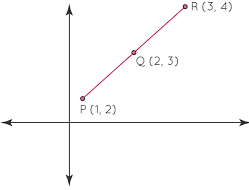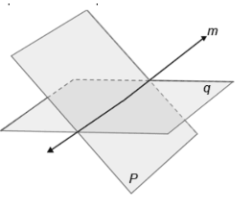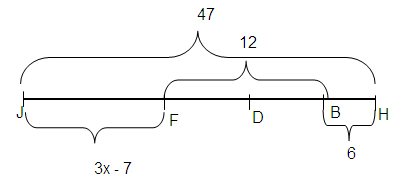POINTS LINES AND PLANES QUIZ
Problem 1 :
Intersecting lines are _____ non-coplanar.
a. always b. sometimes c. never
Solution :
A coplanar line is a line which is in the same plane as another line. Any two intersecting lines must lie in the same plane, and therefore be coplanar.
Intersecting lines are always coplanar.
Intersecting lines are never non-coplanar.
So, option c. is correct.

Problem 2 :
Two non-parallel lines ______ intersect at one point.
a. always b. sometimes c. never
Solution :
Two non-parallel lines always intersect at one point. Parallel lines will never intersect.
So, option a. is correct.
Problem 3 :
Two points are ______ collinear.
a. always b. sometimes c. never
Solution :
Two points are always collinear.
So, option a. is correct.
Problem 4 :
Three points are ______ collinear.
a. always b. sometimes c. never
Solution :
Three points are sometimes collinear.
So, option b. is correct.

Problem 5 :
Three points are ______ coplanar.
a. always b. sometimes c. never
Solution :
Three points are always coplanar.
So, option a. is correct.
Problem 6 :
Four points are ______ coplanar.
a. always b. sometimes c. never
Solution :
Four points are sometimes coplanar.
So, option b. is correct.
Problem 7 :
When two planes intersect, they do so:
a. at a point b. along a line c. along a plane
Solution :
Two planes intersect along a line.
So, option b. is correct.

Plane p and q intersect along line m.
Problem 8 :
All points along a line are ______ collinear.
a. always b. sometimes c. never
Solution :
All points along a line are always collinear.
So, option a. is correct.
Problem 9 :
Opposite rays (circle all that apply):
|
a. are collinear c. sometimes overlap |
b. have the same endpoint d. form a straight angle |
Solution :
Opposite rays have the same end point.
So, option b. is correct.
Problem 10 :
Any two rays are _______ congruent.
a. always b. sometimes c. never
Solution :
Any two rays are always congruent.
So, option a. is correct.
Problem 11 :
Any two segments are _______ congruent.
a. always b. sometimes c. never
Solution :
Any two segments are sometimes congruent.
So, option b. is correct.
Problem 12 :
If points A, B, C are collinear with C between A and B, the segment addition postulate is :
a. AB + BC = AC b.BA + CB = AC c. BC + CA = AB
d. BC + AC = CA
Solution :

By observing the figure,
BC + CA = AB
So, option c. is correct.
Problem 13 :
Two rays that have a common endpoint could form (check all that apply):
a. an angle b. a straight line c. opposite rays
d.a vertex
Solution :
An angle is formed by two rays with a common endpoint.
So, option a. is correct.
Problem 14 :
Points J, K and L are collinear with J between L and K.
KJ = 2x + 3, LK = 9x – 7 and LJ = 4x + 8.
Draw a diagram, solve for x, and find the measures for KJ, LJ and LK.
Solution :

Given KJ = 2x + 3
LK = 9x – 7 and
LJ = 4x + 8.
LJ + JK = LK
4x + 8 + 2x + 3 = 9x - 7
6x + 11 = 9x - 7
11 + 7 = 9x - 6x
18 = 3x
18/3 = x
6 = x
KJ = 2(6) + 3
= 12 + 3
KJ = 15
LK = 9(6) – 7 and
LJ = 54 - 7
LK = 47
LJ = 4(47) + 8
= 188 + 8
LJ = 196
Problem 15 :
Points B, D, F, H and J are collinear and are in the following order.
a. D is between J and B b. F is between D and J
c. B is between F and H
d. JH = 47, FB = 12, FD = DB = BH and JF = 3x - 7
Draw a diagram of the points, solve for x and solve for JF.
Solution :

JH = 47
FB = 12,
FD = DB = BH and
JF = 3x - 7
BH = FB - DB
= 12 - 6
BH = 6
D is the midpoint of FB.
B is the midpoint of DH.
JF = JH - FB - BH
= 47 - 12 - 6
= 35 - 6
JF = 29
3x - 7 = 29
3x = 29 + 7
3x = 36
x = 12
Recent Articles
-
Finding Range of Values Inequality Problems
May 21, 24 08:51 PM
Finding Range of Values Inequality Problems -
Solving Two Step Inequality Word Problems
May 21, 24 08:51 AM
Solving Two Step Inequality Word Problems -
Exponential Function Context and Data Modeling
May 20, 24 10:45 PM
Exponential Function Context and Data Modeling